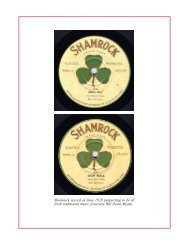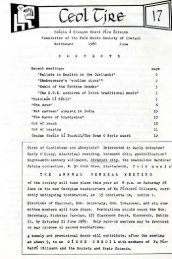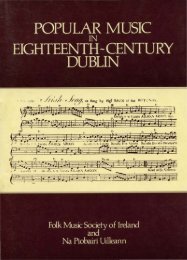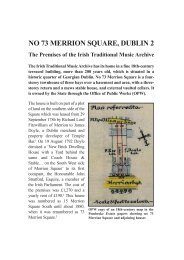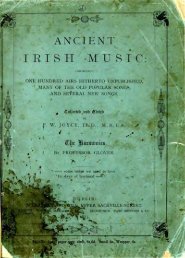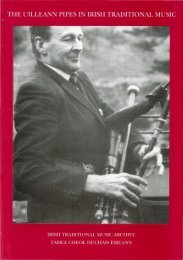Union Pipes - Irish Traditional Music Archive
Union Pipes - Irish Traditional Music Archive
Union Pipes - Irish Traditional Music Archive
You also want an ePaper? Increase the reach of your titles
YUMPU automatically turns print PDFs into web optimized ePapers that Google loves.
59 COURTNEY’S ‘UNION PIPES’ AND THE TERMINOLOGY OF IRISH BELLOWS-BLOWN BAGPIPES<br />
[Edinburgh]... Captain Skeene sung a song alluding to the union of<br />
the three kingdoms. Mr Fitzmaurice played several tunes on the<br />
<strong>Union</strong> pipes... 165<br />
The term must certainly have been used in this way by <strong>Union</strong>ists and<br />
other interested parties at other times, giving support and circulation<br />
to the spurious explanation, and leading with the passage of time to a<br />
belief in its validity. ‘<strong>Union</strong>’ was a bad brand-name in Ireland, and<br />
this undoubtedly had an influence on the eventual demise of the term<br />
in the twentieth century, and the vehemence with which it was<br />
rejected by some.<br />
United Chanter, Drones, Regulators, or Concords of Sound<br />
A plausible and therefore very widely accepted explanation for<br />
‘union pipes’ has been that these pipes – unlike medieval bagpipes<br />
and the contemporary Scottish Highland bagpipes – unite their<br />
drones in a single cylindrical unit or ‘common stock’ in which the<br />
heads of the drone-pipes lie side by side and are fed with air by the<br />
bag through the stock. An expansion of this idea is that the union in<br />
question may have been that of the existing chanter and drones with<br />
a new keyed closed chanter or ‘regulator’. 166 As said, a single<br />
regulator is first mentioned in the late 1780s, in Ireland; over the<br />
following decades more would be added.<br />
Related to this explanation of the physical union of hardware is the<br />
idea that the unusually many pipes of the instrument provide a close<br />
sonic union – a balanced chorus. Some support for this explanation<br />
is found in a 1772 Dublin verse translation from the Latin of Horace<br />
which says that ‘the Bagpipe’s Drone,/ May hum in drowsy<br />
Unison’, 167 and in a Scots Gaelic dictionary of 1825 which translates<br />
165<br />
Caledonian Mercury, Edinburgh, 8 Dec. 1806.<br />
166<br />
This addition of the regulator is considered by Hall 1842: 412–3 to distinguish<br />
the <strong>Irish</strong> bagpipes in their ‘primitive form’ from the ‘improved or union pipes’.<br />
167<br />
Public Advertiser, London, 24 Apr. 1772.



